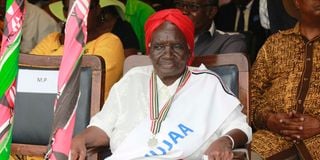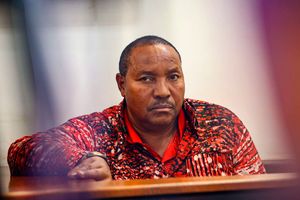Premium
Why some readers were not happy with pick of most inspiring women

Kenya’s first woman MP, Grace Onyango, at Jomo Kenyatta Sports Ground in Kisumu for a past Madaraka Day celebrations.
The list, readers were told, was “not exhaustive.” But that didn’t stop them from faulting “Kenya@60: Celebrating 60 of the most inspiring Kenyan women”.
Published last Friday in the Nation, the list was as refreshing as it was controversial. It included Lisa Gem, aged 10, known for raising awareness of the needs of cancer survivors, and Linet Toto, who at 25 is the youngest MP.
The two Margarets in the Kenyatta family were also featured. Wambui, the first Nairobi woman mayor, who died in 2017 at 89, was number 15 on the list. She was followed by Wanjiru, the former First Lady, who is 59.
“I cast my eye over the photos of those recognised and their names,” said Githuku Mungai. “As one who has read newspapers for decades, I looked out for a name that has featured in the past to see if it was included. But it wasn’t there.” Like other readers, he was concerned not so much about who was included but who was left out.
“They left out the first woman mayor, who was also the first elected woman MP, Mrs Grace Onyango,” said Edwin Otieno. “They left out Eddah Gachukia [the educationist and entrepreneur who founded the Riara Group of Schools and Riara University].” He was also concerned that certain media personalities were left out. “How do you leave out Dorothy Kweyu [a former Nation Revise editor and media consultant], Catherine Gicheru [former editor and director of the African Women Journalism Project] and Sarah Elderkin [former managing editor of The Weekly Review]?
In the same vein, and going along with Mr Otieno’s sentiments, one can also question why Rose Kimotho, who founded Kameme FM, and Eunice Njambi Mathu, who founded the Parents magazine, were not included. What was the criteria used to exclude them and other notable women in other fields?
That takes us back to what the story said: The list was not exhaustive. Still, it’s valid to ask what criteria was used for inclusion or exclusion. Lack of space is not a sufficient reason. The Nation could have specified the criteria used. The story said the selected women were “inspiring”, “change-makers”, “incredible”, “inspirational and powerful heroes” and they “shook things up”—whatever that means. But readers needed more specificity.
The Nation could, for instance, have set a cut-off point. This could be age, say under 60, 50 or 40, the assumption being it’s too early to flaunt younger and emerging talents. Or the cut-off could be the type of leadership, perhaps as explained by William Shakespeare in his play Twelfth Night: “Some are born great, some achieve greatness and some have greatness thrust upon them.”
Presentation of the photo-feature
Some readers also had issues with the presentation of the photo feature, which occupied the centre-spread (page 4-5) of the DN2 pullout magazine. But the centre-spread carried only 40 portraits. The remaining 20 were relegated to page 6, which was, effectively, the ‘back page’ of the pullout. Those consigned to page 6, who included Chief Justice Martha Koome, Catherine Kasavuli and Anne Waiguru, appeared like they were lesser luminaries.
The centre-spread photos were beautifully cropped and the graphics by Sydney Kithome created a harmonised visual experience for the reader. In contrast, one got the impression that the graphics artist was already tired of trimming and tidying up photos by the time he got to page 6. Zipporah Kittony, Agnes Pareylo, Janet Wanja, Waiguru, Lora Kiplagat, Rose Tata Muya, Prof Faith Karanja, Susan Mboya and Josephine Sinyo had their photos showing ugly or distractive backgrounds of furniture, equipment, bushes or other faces.
Mr Otieno had an issue with the elevation of Janet Mbugua and Lupita Nyong’o: Their photos were about three times larger and were placed in the middle of the centre-fold. What was the criterion for giving them the pride of place?
The numbering of the list was also mystifying. Wanini Kireri was number one. Josephine Sinyo was number 60. Was the numbering in order of merit? If not, the Nation should have appended an editor’s note saying it wasn’t
The selection, as presented, was bound to leave some readers unhappy. The Nation could have minimised the unhappiness by setting out clear and specific criteria for inclusion and exclusion. That also would have been fairer journalism.
The Public Editor is an independent news ombudsman who handles readers’ complaints on editorial matters including accuracy and journalistic standards. Email: [email protected]. Call or text 0721989264





